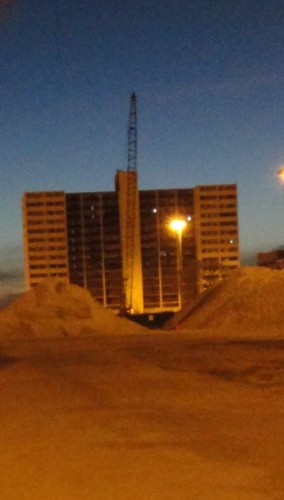
The sunset at 7:22 p.m. on Monday, but the lights came on in the last building left standing at Cabrini-Green, at 7 p.m. according to the Chicago Tribune.
The building is a high-rise, that used to be on Burling, but is now located at Halsted and Division, because the city has closed off Burling St. in preparation for the demolition.
It was cold, even for March, and a biting wind was blowing. Looking west from Larrabee St., fenced out of the block around the surviving building, you can make out the faint blinking of lights that represent a farewell and closure to a chapter of Chicago history that began with a dream of decent housing and devolved over the years into something that often seemed like a nightmare.
More than 200 Chicagoans, mostly teens, worked with artist Jan Tichy initially recording poems and spoken word inspired by the end of Cabrini-Green. The words were connected to the lights which blink on and off reflecting the rhythm of speech. There is a light in each of the 134 apartments.
From Halsted St., looking east, the show is more noticeable. The lights are visible across the face of the building, and they look more explosive. In 1962, Ogden Ave. ran on a diagonal past the corner. Through the first Mayor Daley’s urban renewal plans, Ogden Ave. the street, was replaced by Ogden Ave. the viaduct, or what most people referred to as a bridge. Chicago legend has it that the Mayor used money for bridge-building to elevate Ogden, and separate drivers from the rough neighborhood around Cabrini. According to Forgotten Chicago,
These high rises, known as Cabrini-Green, were comprised largely of poor African-Americans and early on were plagued by crime, drug, and high-vacancy problems. The hopelessness and poverty that came to be associated with this area were a far cry from the ideal that Lincoln Park community leaders were trying to achieve. As writer Greg Beaubien puts it, the removal of Ogden “created a barrier at North Avenue between elite wealth in the Triangle District and crushing poverty around Cabrini-Green.” Lincoln Park and Old Town had been successfully isolated by the removal of Ogden Avenue.
For drivers and bicyclists, driving over the bridge meant being exposed to gun-fire from the towers on several occasions and while the blinking lights can seem like conversations between people in various apartments, they can recall the flash of a gun, as well. The legacy of Cabrini-Green is nuanced, neither all bad nor good, and this art installation quietly recalls, commemorates, and brings closure to a turbulent time and how it played out in our city.
Related articles
- Cabrini-Green Project Closure and Remembrance Through Art (chicagotalks.org)
- As the Lights Go Out in Cabrini, Public Art Illuminates Final Building (chicagoist.com)
- Documenting the Ongoing Story of Cabrini-Green (chicagoist.com)
- As the Walls Come Down (chicagoreader.com)













Be First to Comment